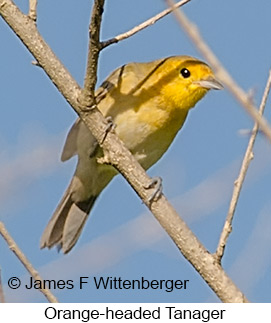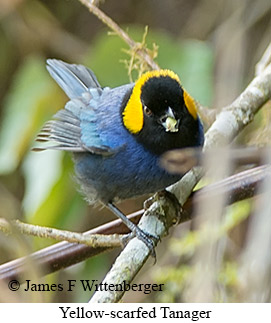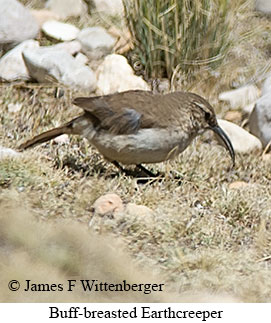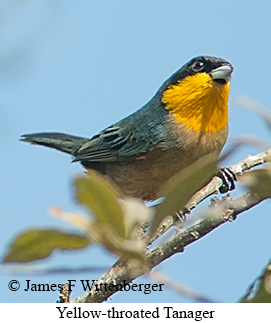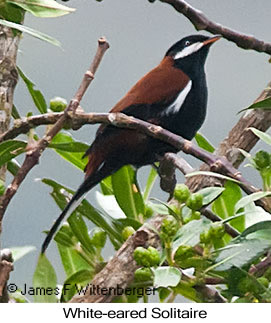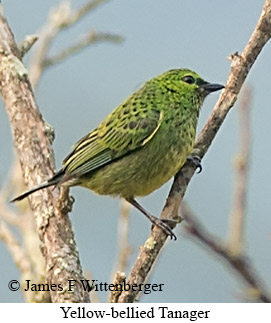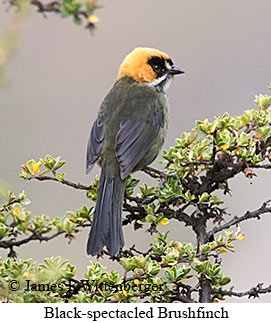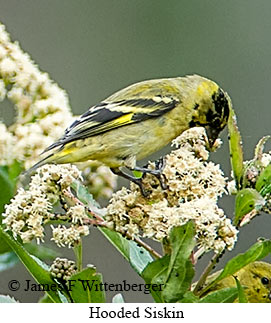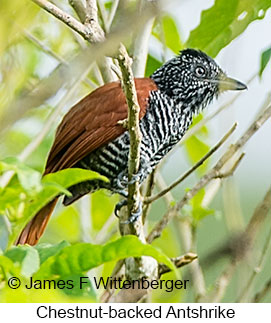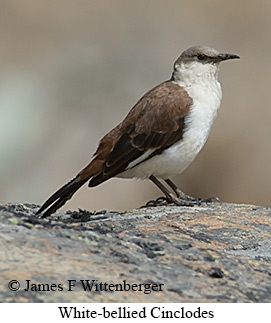CENTRAL PERU BIRDING TOUR
Tour Description

PERU
BIRDING TOUR
ANY TIME*
| Duration: | 15 days, 14 nights |
| Group Size: | 2-6 |
| Anytime Price: | $6150 |
| Group Price: | $5700 |
| Single Suppl: | $550 |
| Est #Species: | 325-375 |
| Pace: | Moderate |
| Difficulty: | Moderate |
| * This tour is available for any dates of your choosing provided guide services and accommodations are available. | |
DAY 1 - LIMA
Arrive at international airport in Lima and transfer to your hotel near the airport. Night at Wasi Airport Hotel.
DAY 2 - LOMAS DE LACHAY & PARAISO LAGOON
Depart early for Lomas de Lachay, an arid hilly area near the coast north of Lima. The habitat is very dry in dry season but surprisingly green during rainy season. The entrance road passes through a flat, arid plain where the main birds of interest are a small desert race of Burrowing Owl, Least Seedsnipe, Coastal Miner, and Grayish Miner. The hills and desolate canyon within the reserve are home to Purple-collared Woodstar, Oasis Hummingbird, Amazilia Hummingbird, Thick-billed Miner, Cactus Canastero, Peruvian Pipit, Peruvian Meadowlark, Band-tailed Sierra Finch, and Grassland Yellow-Finch. Also possible but less likely is the nomadic Raimondi's Yellow-Finch. Then visits to the coastal lagoon around Paraiso and a sandy beach at Albufera will add additional species such as White-tufted Grebe, Great Grebe, West Peruvian Dove, Peruvian Thick-knee, Gray-hooded Gull, Gray Gull, Kelp Gull, Many-colored Rush Tyrant, Peruvian Martin, Long-tailed Mockingbird, and Yellowish Pipit. Various marine species may be seen flying by along the coast, including birds such as Inca Tern, Guanay Cormorant, Peruvian Pelican, and perhaps others. Transfer back to Lima in time for 3:00pm flight to Huanuco. Night at a hotel in Huanuco.
DAY 3 - BOSQUE UNCHOG
We'll depart very early for the quite long drive up a winding, dirt road into the higher elevation paramo above the town of Acomayo and beyond the town of Cochabamba. We'll carry a box breakfast with us. At the end of the road at an elevation of about 3600m (11,800ft), we'll begin walking a trail through alpine grassland, paramo, and eventually stunted forest. The trail leads up and down before dropping steeply down to the valley below. At this altitude the hiking is a bit tiring but well worth the effort. Some 50 years ago a research expedition discovered several new bird species in this area, namely Bay-vented Cotinga, a very strange small tanager named the Pardusco, and the brilliantly colored Golden-backed Mountain-Tanager. These birds are by no means certainties to be seen. The best habitat for the cotinga and mountain-tanager is the Elfin forest found quite far along the trail just before it drops off to much lower elevation. It may be necessary to hike down the steep part of the trail a ways to find these two species. At the third forest patch along the trail, both Chachapayas Antpitta and Rufous-browed Hemispingus are possible. These are the toughest of the several difficult birds to see. Many other specials are likely to be seen along the trail, including Purple-backed Thornbill, Blue-mantled Thornbill, Coppery Metaltail, possibly Undulated Antpitta, Puna Tapaculo, Neblina Tapaculo, White-browed Spinetail, Red-rumped Bush-Tyrant, Rufous-breasted Chat-Tyrant, Brown-backed Chat-Tyrant, and Golden-collared Tanager. Night at a hotel in Huanuco.
DAY 4 - BOSQUE UNCHOG OR BOSQUE MONTEPOTRERO
Finding the key target species, especially Bay-vented Cotinga and Golden-backed Mountain-Tanager, is hit or miss as both species move around. Yet these are highly desirable species. Thus, if they were missed the previous day, this morning will be devoted to revisiting Bosque Unchog in search of them once again. If, on the other hand, those species were seen the previous day, this day will be devoted to visiting a fairly new reserve near Huanuco called Bosque Montepotrero. This community-run forest reserve is one of the more accessible sites for finding the Panao Antpitta, which was recently split from Rufous Antpitta. The bird is quite common in the reserve but rather difficult to actually see. Hiking in the reserve is easy along relatively flat trails along hillsides, with the habitat consisting of a mix of pastures and forest edge. There are other birds of interest present as well, including the equally difficult to see Curve-billed Tinamou along with Black-tailed Trainbearer, Green-tailed Trainbearer, Coppery Metaltail, Black Metaltail, three other species of antpittas and four species of tapaculos that are also difficult to see, Gray-browed Brushfinch, Orange-headed Tanager, Rufous-chested Tanager, the endemic Brown-flanked Tanager, Chestnut-bellied Mountain-Tanager, Plushcap, Rufous-browed Hemispingus, and Golden-billed Saltator. Night at a hotel in Huanuco.
DAY 5 - CARPISH TUNNEL TRAIL & TRANSFER
Early departure for Carpish Tunnel area north of Huanuco. The road winds up through the mountains, and in the absence of trucks it would take maybe 40 minutes to reach the tunnel. However, trucks moving at 5-10mph seem ever present, so it more typically takes an hour and a half to reach the Carpish area. We'll devote the morning to birding the Carpish Tunnel trail, which gradually rises along a steep hillside separating forest above from agricultural lands below. A number of antpittas and tapaculos are possible but difficult to see due to thick understory in the forest. Of these we hope to see Bay Antpitta and Chestnut Antpitta as well as Tshudi's Tapaculo. A good variety of other birds are also present including Rufous-capped Thornbill, Violet-throated Starfrontlet, Golden-headed Quetzal, Gray-breasted Mountain-Toucan, Streak-headed Antbird, Rufous Spinetail, Barred Fruiteater, Barred Becard, White-tailed Tyrannulet, White-banded Tyrannulet, the endemic Unstreaked Tit-Tyrant, Tawny-rumped Tyrannulet, Rufous-webbed Bush-Tyrant, Peruvian Wren, Bay-crowned Brushfinch, Pale-legged Warbler, White-capped Tanager, Rufous-crested Tanager, Black-capped Hemispingus, the very different "White-bellied" subspecies of Superciliaried Hemispingus, Brown-flanked Tanager, Pardusco, Yellow-scarfed Tanager, Plushcap, Drab Hemispingus, Gray-hooded Bush Tanager, and Black-and-white Seedeater. After returning to Huanuco for lunch, depart for Junin, about a 4 hour drive. Enroute stop at a site near Huariaca to look for Rufous-backed Inca Finch. Night at a hotel in Junin.
DAY 6 - JUNIN AREA
Morning birding around the lake and marsh outside Junin. We'll join with a local guide who knows where all the specialties can be seen. First stop is a marsh area where we should be able to lure out Junin Rail with playback for brief views. From there we'll go to a boat launch for a boat ride toward the center of the lake, which is the only way to see Junin Grebes. The population is decreasing but we should be able to see them. After the boat trip, we'll visit several sites to find Golden-spotted Ground Dove, Black-breasted Hillstar, Puna Snipe, Common Miner, Dark-winged Miner, Buff-breasted Earthcreeper, Olive-backed Foliage-gleaner, Junin Canastero, Cordilleran Canastero, and Bright-rumped Yellowfinch with the help of our local guide. We should see Ornate Tinamous along the road, as they are fairly common. We may also be able to see Barn Owl and Lesser Horned Owl, if our local guide still knows of their roosting sites. Afternoon transfer to Villa Rica, about a 4 hour drive. Night at a hotel in Villa Rica.
DAY 7 - BOSQUE SHOLLET & ULCUMANO ECOLODGE
Bosque Shollet is a cloud forest site located between Villa Rica and Oxapampa. Birding is along the road, which has recently been regraded so now there is heavier traffic than previously. This cloud forest site offers good birding with several key species present. We'll spend the morning birding this area. Birding is a bit of a challenge in the dense understory. Of special interest are the range-restricted Black-winged Parrot, Trilling Tapaculo, Long-tailed Tapaculo, Rufous-vented Tapaculo, Buff-browed Foliage-gleaner, possibly even Chestnut-crested Cotinga, Inca Flycatcher, and Rufous-bellied Bush-Tyrant. Also possible are Bar-bellied Woodpecker, Black Antbird, Chestnut-winged Foliage-gleaner, White-eared Solitaire, Tricolored Brushfinch, Yellow-throated Tanager, Silvery Tanager, Blue-and-black Tanager, and Bluish Flowerpiercer. Afternoon transfer to Ulcumano Ecolodge in the highlands above the town of Oxapampa. After arrival, visit the canopy tower where Chestnut-crested Cotinga can usually be seen. Night at Ulcumano Ecolodge.
DAY 8 - ULCUMANO ECOLODGE
There is good forest around the lodge. Birding is mainly from the access road as well as a dirt road leading to the access road where traffic is heavier. We'll spend all day birding along these roads as well as possibly revisiting the canopy tower. Numerous species are possible including Speckled Hummingbird, Emerald-bellied Puffleg, White-bellied Woodstar, White-bellied Hummingbird, Black Hawk-Eagle, Bay Antpitta, Rufous-vented Tapaculo, Buff-browed Foliage-gleaner, Masked Fruiteater, Fulvous-breasted Flatbill, Yellow-crowned Tyrannulet, Black-capped Tyrannulet, Peruvian Tyrannulet, Rufous-tailed Tyrant, White-eared Solitaire, Tricolored Brushfinch, Fawn-breasted Tanager, Blue-and-black Tanager, Flame-faced Tanager, Bluish Flowerpiercer, and Gray-hooded Bush Tanager. At dusk Swallow-tailed Nightjars can often be found along the road. Owling in the evening may produce Cloud-forest Screech-Owl and Rufous-banded Owl. Night at Ulcumano Ecolodge.
DAY 9 - ULCUMANO ECOLODGE & TRANSFER
Morning birding around the lodge grounds. After lunch, transfer to Satipo, about a 3 hour drive. Night at a hotel in Satipo.
DAY 10 - SATIPO ROAD
Depart early for the drive up the Satipo Road toward the village of Calabaza. Much of this section of the road is agricultural but a good variety of birds are possible, including Chestnut-collared Swift, Black-and-chestnut Hawk-Eagle (rare), Lemon-throated Barbet, Chestnut-eared Aracari, Lafresnaye's Piculet, Yellow-tufted Woodpecker, Crimson-crested Woodpecker, White-eyed Parakeet, Black-tailed Tityra, Black-crowned Tityra, Black-capped Becard, White-collared Jay, Violaceous Jay, Olivaceous Siskin, Magpie Tanager, White-bellied subspecies of Superciliaried Hemispingus, Yellow-bellied Tanager, and Dull-colored Grassquit. After lunch at a restaurant in Calabaza, bird the upper section of Satipo Road. Many additional species are possible including Wire-crested Thorntail, Sword-billed Hummingbird, Sapphire-spangled Emerald, Andean Motmot, Montane Woodcreeper, Mountain Wren, Common Chlorospingus, Gray-browed Brushfinch, Slaty Brushfinch, Pale-legged Warbler, Capped Conebill, and Cinereous Conebill. Evening look for Lyre-tailed Nightjar outside town. Night at a very basic community center outside Calabaza.
DAY 11 - ANDAMARCA VALLEY
All day birding an altitudinal transect into the Andamarca Valley and down toward the Mantaro Valley. The first stop is at quite high altitude paramo where the main target species is the Jalka Tapaculo. We'll then work our way downslope where we expect to find Creamy-crested Spinetail, Rufous-breasted Chat-Tyrant, Black-spectacled Brushfinch, Moustached Flowerpiercer, and Golden-billed Saltator. Still lower we'll be targeting two subspecies that are likely future splits, Mantaro Spinetail, a likely split from Azara's Spinetail, and Mantaro Wren, a likely split from Plain-tailed Wren. We will continue down the canyon all the way to the town of Andamarca and beyond into the Mantaro Valley where a third undescribed form, the Mantaro Thornbird is found. In the same area we'll also seek out the poorly known endemic Koepcke's Screech-Owl. Many other birds are possible as well, including Mountain Velvetbreast, Rufous-vented Whitetip, Stripe-headed Antpitta, Cream-winged Cinclodes, Cactus Canastero, Red-crested Cotinga, Highland Elaenia, Hooded Siskin, Yellow-breasted Brushfinch, Black-backed Grosbeak, Rufous-chested Tanager, Black-goggled Tanager, Buff-bellied Tanager, Grass-green Tanager, Chestnut-bellied Mountain Tanager, Black-throated Flowerpiercer, and Plain-colored Seedeater. Night at the community center outside Calabaza.
DAY 12 - UPPER SATIPO ROAD & FONDO ARMORIQUE
Early morning drive up the Satipo Road to the Carrizales Bridge. The main target birds at this higher elevation site are Fire-throated Metaltail, Junin Antpitta, Junin Tapaculo, and Eye-ringed Thistletail. We'll then work our way back down toward Calabaza. A good variety of more widely distributed species are possible along this transesct. After lunch, transfer to Hacienda Armorique in the highlands above the town of La Merced. After arrival, there may be some time to bird the road just up from the lodge. At this lower elevation, birds such as Rufous-capped Nunlet, Bluish-fronted Jacamar, Lafresnaye's Piculet, Yellow-breasted Warbling-Antbird, Cabanis's Spinetail, White-bellied Pygmy-Tyrant, Yellow-crested Tanager, and Black-faced Dacnis are possible. This site is often good for finding owls, and we'll drive up the rough road after dinner to seek them out. Most likely are Rufescent Screech-Owl, the poorly known Cloud-forest Screech-Owl, and Rufous-banded Owl. Night at Hacienda Armorique.
DAY 13 - HACIENDA ARMORIQUE & TRANSFER
We'll depart early with the owner of the hacienda and drive upwards to higher elevation along a rough road. The main target species are the endemic Creamy-bellied Antwren and Cerulean-capped Manakin. Other birds we may see include Little Tinamou, Ocellated Piculet, Chestnut-backed Antshrike, Blackish Antbird, White-crowned Manakin, Streak-necked Flycatcher, Three-striped Warbler, Fawn-breasted Tanager, Spotted Tanager, Blue-necked Tanager, and Peruvian Sierra Finch. Afternoon transfer to San Marcos area. Night at a hotel near San Marcos.
DAY 14 - MARCAPOMACOCHA, MILLOQ BOG, & SANTA EULALIA
Depart early for the highlands around Marcapomacocha, stopping at a restaurant for breakfast enroute. First stop is a pullout along the main road to look for the endemic and range-restricted White-bellied Cinclodes. Continue into the highlands, making several stops along the way including the Milloq bog area where we hope to find the rare Diademed Sandpiper-Plover. This species is most likely seen during breeding season from October to March but is possible at other times of year as well. Other birds of interest include Green-headed Hillstar, Rufous-bellied Seedsnipe, Gray-breasted Seedsnipe, Buff-breasted Earthcreeper, Streak-backed Canastero, Spot-billed Ground-Tyrant, Puna Ground-Tyrant, Dark-faced Ground-Tyrant, White-browed Ground-Tyrant, Glacier Finch, Ash-breasted Sierra Finch, Slaty Finch, Mourning Sierra Finch, Rufous-breasted Warbling Finch, and Bright-rumped Yellow-Finch. Continue across the mountain and down the other side into the Santa Eulalia Valley where an altitudinal transect down this very scenic valley may yield Torrent Duck, Giant Hummingbird, Rusty-crowned Tit-Spinetail, Thick-billed Siskin, Rusty-bellied Brushfinch, Drab Hemispingus, Greenish Yellow-Finch, and possibly some raptors. From there drive on to Lima. Night at Wasi Airport Hotel
DAY 15 - ARRIVAL
End of tour in the morning. Transfer to airport for flight home.
ADDITIONAL INFO
(Not on Menu Above)
BIRDING LOCALES
